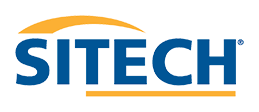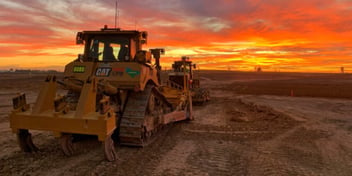Delivering Sydney's New Airport Project
The massive Bulk Earthworks project, under development by the federal government-owned Western Sydney Airport (WSA), entails construction of an international airport on the western side of Sydney, Australia.
ACCIONA and CPB Contractors have been working as joint venture partners to deliver the Western Sydney Airport Bulk Earthworks Project. Meeting the demands of the client have required the partners to use sophisticated machine control technology, so as to maintain high earthwork production while meeting quality conformance targets.
To tackle the challenges, of the project the joint venture partners opted to deploy one of the industry’s first near-real-time, continuous loop office-to-machine data workflows.
The joint venture partners are having to move, fill and compact some 24 million m3 of earth to a set of tight specifications in a short space of time. In addition the site includes complex soil challenges, as it sits on top of the Bringelly Formation, an ancient river delta system. Consequently, the material can be highly variable and reactive in some areas, and post construction settlement is a risk.
For surveyors and equipment operators, the earthworks project presented a challenging data management task. This could easily have resulted in missed, misplaced or inaccurate data and delays for approvals. And at any given moment there might be over 270 construction machines operating on the job.

Daniel Ripley, ACCIONA’s Australia’s Central Region survey manager for Construction in Australia, said, “We needed to be able to send updated models to the field crews as multiple times a day.”
“The joint venture team had a plan to place material more efficiently and then report on that material placement,” said Nicholas Pryke, manager of sales mining, aggregates and landfill with SITECH Solutions Pty and technical advisor to the joint venture team. “Our job was to find the technology-enabled, connected solution that could operate within the constraints of the plan and across a blended fleet to meet stringent specifications.”
Early on, the design team defined clear specifications for density, moisture content, layer thickness and material traceability, from source to placement, to meet the critical end product criteria.
Prior to work commencing, the airport site was broken up into lots that vary in size. The boundaries, thickness and volume of each lot had to be recorded and reported. The thickness of placed earthworks material was not to exceed 350mm and the specification further required the lot thickness to be validated every 800m2. The locations of field density and moisture content tests also had to be recorded to an accuracy of +/- 1m.
These specifications posed a challenge. In the past, the project team would have used conventional spreadsheets and USB sticks for tracking and sharing material movement. But that methodology was not suitable for a project of this size, given the need to share multiple design changes a day to ensure proper layer thickness and optimal material placement.
“The process allowed us to filter and interpret data, create a boundary, process, and finally send the exported information to a conformance program to verify compliance with design, all with machine control, removing staff from site and download data directly from machines,” Ripley said.
The team also needed to ensure personnel in the field had the most up-to-date models and the ability to verify earthwork conformance to specified layer thicknesses. The surveyors needed to track material moved and rolled, and compare as-built surfaces to the base layer thickness in near real-time.
Another concern was safety. With hundreds of machines operating, the joint venture team did not want survey or geotechnical testing staff onsite taking measurements and samples. Working with SITECH Solutions and Trimble, the joint venture team developed a cloud-based survey, compaction, testing and conformance workflow.
As a first step, the joint venture team equipped around 30 utility vehicles and pickup trucks as mobile offices for superintendents, foremen, leading hand and the GITA geotechnical personnel. The vehicles include Trimble SPS986 Rovers with dash mounted tablets running Trimble Siteworks SE Software. They were also given full access to Microsoft 365 for emails, SharePoint drives, video conferencing and more, as well as 3D models, all while in the field and eliminating the need for a laptop. In addition, superintendents were equipped with Trimble positioning technology, allowing them to check grades and levels.
For material tracing, the site vehicles were equipped with on board diagnostic devices (OBD) to report plant ID, GPS location and travel speed. Geofences can be established and defined as fills, cuts or break areas. User defined logic can be programmed so that the system uses data from the OBD to define a load, haul or dump event, and capture cycle times, haul/excavating plant productivity or similar data.
To minimise the need for surveyors to walk the site, the project team fitted compaction equipment with GNSS-enabled machine control systems. Trimble GCS900 cab mounted systems were fitted to drum compactors, while Trimble CCS900 cab mounted GNSS systems went on all smooth drum rollers and most padfoot rollers to monitor layer thickness and elevation. As well, dual mast GNSS Trimble Earthworks systems were fitted to excavators, while graders and dozers were fitted with single and dual mast GNSS solutions to gather data about the correct level, grade and material thickness. Single mast Trimble GCS900 Universal Total Station (UTS) systems were fitted to CMI trimmers, while single mast GCS900 GNSS systems were put on surface miners. The information from the machines could be sent via the cloud to Trimble WorksOS Software and viewed in real time in the machines and on the field supervisor’s tablets in their vehicle.
As operators grade, excavate and compact material, the software logs as built and quality assurance data, which is transferred to WorksOS in real time, where it is processed and displayed. From mobile offices, surveyors can view the data in map and/or dashboard form or filter the data to generate reports about jobsite activity and progress to ensure schedules are met and remotely plan future operations. Once compacted, sealed and signed off, that conformed surface would be reinserted to the current model. Every time a lot is signed off, a new model is developed.

This dynamic workflow is designed to suit production and weather conditions. SITECH’s Pryke, said, “With WorksManager sending datasets on a regular basis, the entire field team, including the geotechnical testers, foreman, operators and surveyor, sees the same lot surface for a given day.”
The surveyor defines the boundary of the lot in WorksOS, and in the cab, the operators see the current surface model as shared by WorksManager into the machine control system. As materials are moved and compacted, the machine measures the as-built data and then sends the data to WorksOS for processing and analysis. The data can be shared with surveyors to verify conformance to defined elevation and thickness specifications.
The geotechnical testers (ASCT), using WorksOS, are notified at the end of each day which lots are completed so that they can run the required soil tests for density and moisture. Once a lot meets conformance targets, it is closed by the engineers and then the survey team recreates the larger surface, starting the process again.
Using WorksOS, everyone is able to see the quality of the work on an interactive map. The data is then combined with geotechnical data, such as optimum moisture content and density, for final conformance and quality assurance reporting.
“It sounds simple, but remember the data was shared many times a day between surveyors and operators,” Brett Hussey, project survey manager at ACCIONA, said. “At our peak, we had eight surveyors reporting as material was placed and graded, and we were doing up to 10 design updates a day. Every single bit of fill material was tracked. We knew every slice of fill down to the size of a tree stump hole. Even those holes had to be filled to a predetermined layer thickness.”
The advantage of the field-to-office-to-field workflow was that it allowed the foreman and machine operators to know where they could place fill without physical stakes and survey marks, enabling them to build the site with minimal surveying methods.
Hussey said, “Without this digital workflow, the process would have been very laborious and we would have lost the ability to keep surveyors off the site. We would have had to take a much more hands-on approach. Every material layout is accountable, so the quality of the job was the biggest improvement, as was our ability to maintain high production.”

WorksOS has also provided a logistical advantage while working on the massive airport site. “We used WorksOS to optimise machine routes, a capability we hadn’t even considered,” he added.
“With WorksOS, we were able to show operators the importance of their work on a daily basis. They’re not out there just moving dirt; they’re producing a product that is seen and reported on every day. They visually see the value of their work,” he explained. “We’ve empowered them and, as a result, the quality of the work has also risen. Our roller operators feel like they are the most important people on the project.”
Ripley added, “Surveyors were freed up to focus on the reporting side of the project, while foremen and operators were empowered to check on how they are progressing, meeting productivity, and in compliance to specs.”
Read the full article as published in World Highways. For more information, go to www.sitechsolutions.com.au or contact us today using the below form.


